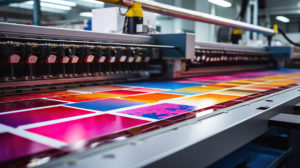
With a rich history exceeding 30+ years in the print industry, ARC has established itself as a seasoned expert, delivering innovative solutions in document and information management. In this comprehensive guide, we’ll dive into nine of the most prevalent mistakes made during the file preparation stage when working with print shops. Moreover, we’ll equip you with valuable insights and tips to not only avoid these pitfalls but also enhance your overall printing experience.
Understanding the Precision of Professional Printing: The Crucial Art of File Preparation
Stepping into the intricate world of professional printing requires a keen eye for detail, especially when it comes to file preparation. Ensuring your files are meticulously prepped is not just a routine step—it’s a pivotal process that can significantly impact the outcome of your print job! Stop and take a moment to double-check these items before you send your files out to be printed at the shop.
1- Insufficient Image Resolution: A Pixel’s Perspective:
At the core of visually striking prints lies the resolution of your images. The mistake of submitting images with insufficient resolution—commonly below the recommended 300 DPI—can lead to disappointing outcomes. We emphasize the importance of understanding and adhering to the DPI guidelines for optimal print quality. No matter how cool your project is, if it’s fuzzy, it’s going to look bad.
2- Incorrect Color Mode: RGB vs. CMYK: A Color Conundrum:
The RGB vs. CMYK dilemma is a common crossroads. While RGB is ideal for digital screens, CMYK is the go-to for print. We’ll delve into the intricacies of color modes, explaining why proper color mode selection is essential to achieve accurate and vibrant prints.

-
- RGB (Red, Green, Blue):
- RGB is an additive color model primarily used for digital displays such as monitors, cameras, and screens.
- It combines varying intensities of red, green, and blue light to create a broad spectrum of colors.
- Well-suited for projects destined for electronic viewing, RGB provides vibrant and dynamic visuals.
- Think: media viewed on a screen
- CMYK (Cyan, Magenta, Yellow, Key/Black):
- CMYK is a subtractive color model utilized in print materials like brochures, posters, and magazines.
- It involves layers of translucent ink in four primary colors—cyan, magenta, yellow, and black—to produce a spectrum of hues.
- Ideal for achieving accurate and consistent colors in printed materials, CMYK is the standard for professional printing.
- Perfect for printing on materials
- RGB (Red, Green, Blue):
Understanding these nuances helps ensure that your design elements appear consistent and visually appealing across various mediums. When preparing files for print, it’s crucial to choose the right color mode based on the intended output, whether it’s vibrant digital displays or precise and vivid printed materials.
3- Ignoring Bleed and Trim Areas: Beyond the Edge:
White borders disrupting your design? The omission of bleed and trim areas might be the culprit. Bleed is the extra space beyond the trim edge of a document, ensuring that printed pieces look polished. It eliminates white borders, compensates for trimming variations, facilitates full bleed printing, and enhances design freedom. By extending your design elements beyond the trim area, bleed guarantees a professional finish, accommodating potential shifts during printing and trimming! Making sure you extend the edges of your file guarantees you’ll get back the correct project!
4- Using Incorrect File Formats: PDF Prowess:
In the realm of print, PDF files reign supreme. We’ll explore the perks of PDFs—maintaining formatting, cross-platform compatibility—and highlight the common errors associated with submitting files in incompatible formats.
Perks of PDFs:
-
- Formatting Consistency:
- PDFs maintain consistent formatting across devices and platforms, ensuring the intended layout, fonts, and images are preserved.
- Formatting Consistency:
-
- Cross-Platform Compatibility:
- PDFs are universally compatible, offering a seamless viewing experience on different operating systems and devices.
- Cross-Platform Compatibility:
-
- Print-Ready Quality:
- PDFs are print-ready, eliminating layout discrepancies and making them suitable for professional printing.
- Print-Ready Quality:
-
- Security Features:
- PDFs provide security features such as password protection and encryption for confidential documents.
- Security Features:
Common Errors with Incompatible Formats:
-
- Loss of Formatting:
- Incompatible formats may lead to the loss of formatting, causing discrepancies in fonts, images, and layouts.
- Loss of Formatting:
-
- Font Issues:
- Specific fonts in incompatible formats may result in substitutions and alter the document’s appearance.
- Font Issues:
-
- Platform-Specific Challenges:
- Some formats are platform-specific, creating difficulties when opened on different operating systems.
- Platform-Specific Challenges:
-
- Print Compatibility Problems:
- Incompatible formats can pose challenges in professional printing, whereas PDFs are print-ready and ensure smooth compatibility.
- Print Compatibility Problems:
5- Overlooking Font Embedding: The Font Fiasco:
Fonts are the unsung heroes of design. Yet, overlooking font embedding can lead to unforeseen challenges. Font embedding is a critical aspect of maintaining design integrity in digital documents. When fonts are embedded, they become an integral part of the document, ensuring that the original typefaces are preserved regardless of where the document is viewed. This is especially crucial when sharing files across different devices and platforms.
Without font embedding, reliance on system fonts may lead to substitutions, resulting in a loss of design consistency and readability. By embedding fonts, designers guarantee that their intended typography remains intact, providing a seamless and uniform visual experience for users across various environments.
6- Ignoring Rich Black Composition: Shades of Black:
Black may seem straightforward, but achieving the perfect shade requires finesse. We’ll explore the concept of rich black composition—its formulation and why it’s paramount to prevent black from appearing washed out or lackluster. Rich black composition is a crucial technique in design, involving the formulation of black using a mix of CMYK ink rather than using 100% black (K) alone. This blend, often achieved by adding small percentages of cyan, magenta, and yellow, prevents black from appearing washed out or lackluster, especially in large, solid areas.
Standard black ink can sometimes look dull, but rich black adds depth and vibrancy, enhancing visual impact. This technique is paramount in print design, ensuring that black areas maintain richness and intensity, contributing to the overall visual appeal and preventing a flat or muted appearance. Make sure you double-check your black settings on your project for the best results.
7- Neglecting Layer Organization: The Layered Symphony:
Design organization is an art form in itself! We’ll unravel the importance of layer organization, offering practical tips on proper layer naming and grouping to not only streamline collaboration but also ensure flawless print execution. Layer organization is pivotal in design, contributing to streamlined collaboration and flawless print execution. Properly naming and grouping layers enhances clarity for collaborators, making it easier to navigate complex projects.

When preparing files for print, a well-organized layer structure ensures that each element is easily identifiable, reducing the risk of errors during the printing process. Clear and descriptive layer names, coupled with logical grouping, enable efficient communication between team members and print service providers. This meticulous organization not only enhances collaborative workflows but also plays a crucial role in achieving precise and error-free prints, ultimately saving time and resources. So make sure you name and organize those layers!
8- Forgetting to Proofread: Typos and Beyond:
Typos and design errors can be the undoing of an otherwise impeccable print job! Proofreading is of paramount importance in the print preparation process, ensuring the accuracy and quality of the final output. Meticulously reviewing files before submission involves thoroughly checking text for spelling, grammar, and formatting errors. Additionally, attention should be given to image resolution, color accuracy, and proper bleed and trim settings. Utilizing spell-check tools, collaborating with a second set of eyes, and taking advantage of professional proofreading services are effective strategies. By investing time in careful proofreading, designers can catch potential issues early, guaranteeing a polished and error-free print job that aligns with the intended design and meets high-quality standards.
9- Not Communicating Print Specifications: Bridging the Communication Gap:
Clear communication is the linchpin of a successful print job. Effectively communicating print specifications to your print shop is essential for ensuring seamless alignment between your expectations and the final product. Begin by providing detailed information on paper type, size, and finish. Clearly articulate color preferences using specific color codes or references. Specify any special finishes, such as coatings or laminations. Communicate quantities, deadlines, and any unique requirements. Regularly engage in open communication with your print shop to address questions and clarify details. By establishing a clear and comprehensive dialogue, you enhance the likelihood of your print job meeting or exceeding expectations, fostering a collaborative and successful print production process.
Navigating print prep demands a combination of vigilance, knowledge, and effective communication. By avoiding these common mistakes, you not only safeguard your time and resources but also elevate your print projects to new heights. We’ve unraveled the intricacies of file preparation, providing you with a comprehensive guide to enhance your printing experience.
Remember, success in print preparation lies in the details—heed them, and watch your designs come to life in vivid, flawless prints!